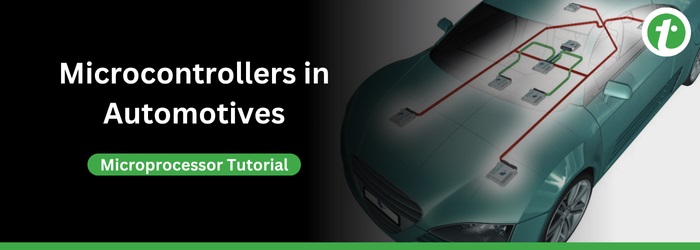
- Microprocessor - Home
- Microprocessor Overview
- Microprocessor Classification
- Microprocessor Evolution
- Microprocessor Components
- Microprocessor Characteristics
- Microprocessor Functions
- Microprocessor Pros & Cons
- Microprocessor Application
- Microcontrollers Types
- Microcontrollers Pros & Cons
- 8085 Microprocessor Architecture
- 8085 Microprocessor Pin Configuration
- Addressing Modes & Interrupts
- 8085 Microprocessor Instruction Sets
- 8085 Microprocessor Features
- Externally Initiated Operations
- 8086 Microprocessor
- 8086 Microprocessor Overview
- Functional Units
- Pin Configuration
- Instruction Sets
- 8086 Microprocessor Interrupts
- 8086 Microprocessor Addressing Modes
- 8086 Microprocessor Features
- Memory Segmentation
- Auxiliary Carry Flag
- Maximum and Minimum Mode Configurations
- Multiprocessor Configuration
- Configuration Overview
- 8087 Numeric Data Processor
- I/O Interfacing
- I/O Interfacing Overview
- 8279 Programmable Keyboard
- 8257 DMA Controller
- Serial vs Parallel Communication
- Serial Communications Interface
- Parallel Communication Interface
- 8051 Microcontrollers
- Microcontrollers Overview
- 8051 Microcontrollers Architecture
- 8051 Pin Description
- 8051 Input Output Ports
- 8051 Microcontrollers Interrupts
- Instruction Sets
- Logical Instructions in AVR
- Conditional Branch Instructions AVR
- Arithmetic Instructions in AVR
- External Memory Interfacing
- Time Delay in AVR
- 8051 vs PIC Microcontroller
- Peripheral Devices
- Peripheral Devices
- Programmable Peripheral Interface
- Intel 8255A Pin Description
- Programmable Interval Timer
- 8253/54 Operational Modes
- Interfacing Devices
- Applications and Furture Trends
- Microcontrollers - Application
- Microprocessors and Microcontrollers in IoT
- Microcontrollers in Automotive Systems
- Microcontrollers - Low-Power
- Artificial Intelligence Processors
- Microprocessor Useful Resources
- Microprocessor - Quick Guide
- Microprocessor - Useful Resources
- Microprocessor - Discussion
Microcontrollers in Automotive Systems
Modern vehicles are not just mechanical machines; they are smart and interconnected systems having smart electronic devices and software integrated with them. One such smart electronic device that is widely used in automotive systems are microcontrollers. A microcontroller is nothing but a small electronic device containing a computer on a single chip that provides control functionalities of electronic processes in vehicles.

In automotive systems, microcontrollers are used for a number of applications like automatic turn on/off headlights, advanced driver assistance, music system control, safety, and many more. Read this chapter to get an overview of how microcontrollers play a vital in automotive systems.
What is a Microcontroller?
A microcontroller is nothing but a small integrated circuit designed to control a specific operation in an embedded system. It typically consists of a central processing unit for execution of instructions, a memory unit for temporary or permanent storage of data, IO ports for connecting sensors and other peripheral devices, etc.
In simple terms, we can state that a microcontroller is simply a small computer on a single chip, specifically designed to perform a task.
Features of Automotive Microcontrollers
Microcontrollers offer several features that make them an ideal device to use in automotive systems, some of the key features are listed below −
- Real-time data processing capabilities
- Small size and simple design
- Low cost
- Need less power to function
- Ability to handle harsh conditions
Functions of Microcontrollers in Automotive Systems
Microcontrollers are used in each and every part of modern vehicles in order to ensure their efficient and reliable operation.
Here is a list of some of key functions that microcontrollers perform in automotive systems −
- Microcontrollers are used in engine control unit to process sensors data, optimize fuel injection, and control emissions.
- In automatic transmission systems, microcontrollers play a significant role in gear shifting depending on speed, load, and road conditions.
- Microcontrollers also empower anti-lock braking system to prevent wheel locking during sudden stops. For this purpose, microcontroller receives data from wheel speed sensor and processes them to adjust brake pressure.
- Microcontrollers are also used in airbag deployment system to process crash sensor input data.
- Microcontrollers are also used to control the operation of body electronics of vehicles like lights, infotainment system, power windows, air conditioner, etc.
- Microcontrollers play another important role in automotive systems which is called advanced driver assistance. In this system, microcontroller processes data from cameras, radar, and other types of sensors to help in lane-keeping, cruise control, collision prevention, parking assistance, etc.
Examples of Automotive Microcontrollers
Given below is a list of some popular examples of microcontrollers specially designed for and used in automotive systems −
- S32K, MPC5xxx are automotive microcontrollers developed by NXP. These microcontrollers are designed by focusing on safety and scalability.
- SPC5, STM32 Auto are designed by STMicroelectronics.
- AURIX and XC2000 developed by Infineon.
- RH850 and RL78 developed by Renesas.
Conclusion
From the above discussion, we can conclude that microcontrollers are key components of modern automotive systems. Microcontrollers make vehicles smarter, safer, and efficient by handling critical operations.
